
ear-neutral PH, T. Aurantia does this using an enzyme called silicatein to catalyse the conversion of silicic acid in seawater into its silica spikes.
The orange puffball sponge, Tethya Aurantia naturally synthesises pristine layers of silica without benefit of high temperatures or low pressures.
N
ear-neutral
PH, T. Aurantia does this using an enzyme called silicatein to
catalyse the conversion of silicic acid in seawater into its silica
spikes.
Structures like this are known to make photovoltaic cells more efficient.
Scientists are developing a low energy process that produces structured layers of zinc oxide, a widely used solar cell semiconductor.
Birgit Swchwenzer at the University of California, Santa Barbara says there are problems but the process seems to be working at really low temperatures and producing devices at really low cost.
(Paul Marks, “Sea Sponge leads the way to cheaper solar cells”, New Scientist, Vol 2596, 24 March 2007, p32)
B1b4_n1